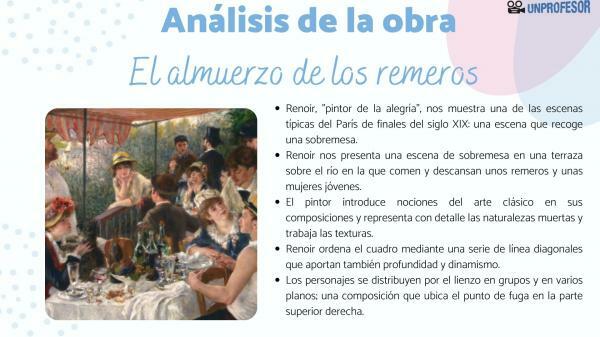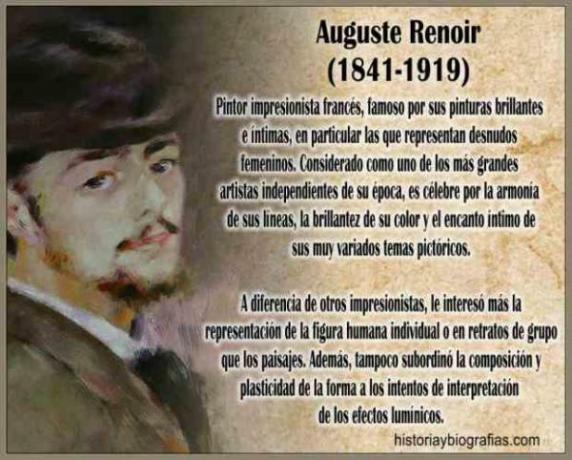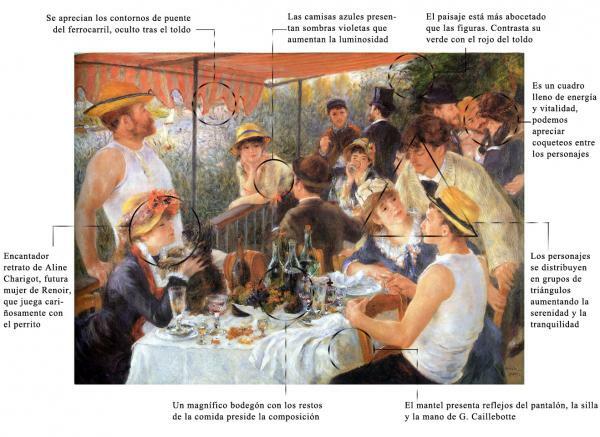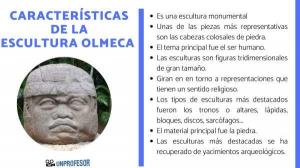The RENOIR rowers' lunch

Pierre Auguste Renoir (1841-1919) is one of the main impressionist painters along with Monet, Sisley, Manet or Degas. An original, creative painter with great interest in landscape, the female body, as well as, and unlike the rest of the impressionists, in interior scenes. The rowers' lunch (1881) is a clear example of Renoir's interest in scenes from everyday life, without further messages, and in which people become protagonists, capturing scenes full of serenity and bonhomie.
In this lesson from unPROFESOR.com we offer you a analysis and commentary of The Rowers' Lunch so you can learn more about Renoir's artistic style.
Index
- Auguste Renoir, the artist who painted "The Luncheon of the Rowers"
- Analysis of "The Rowers' Lunch" and Commentary
- Composition of "The lunch of the rowers"
- History of the work
Auguste Renoir, the artist who painted "The Luncheon of the Rowers"
"The rowers' lunch" is one of the works of Auguste Renoir, a
impressionist painter well known in art history. The characteristics of his painting are as follows:- Renoir Pinta inconsequential themes, scenes from everyday life and also outdoor scenes, following the impressionist style.
- Light and pure colors they take on a key role in his style.
- It has a simple and clear language.
- Renoir treats all the protagonists of his paintings with great delicacy, portraying them in smiling and relaxed attitudes, immersed in talks, conversations, dances, etc. A witness to domestic intimacy and fashions which introduced the middle classes to art.
- In addition to using and discovering the effects of light and optics, Renoir noted the need to maintain the composition and a solid structure in each work.

Image: History and Biography
Analysis of "The rowers' lunch" and commentary.
Renoir presents us with a tabletop scene on a terrace by the river where rowers and young women eat and rest, as well as other bar patrons. The rowers wear their uniforms, while they wear a wardrobe in the fashion of the time. All the characters are close friends of the painter, some painters and art dealers, as well as his future wife, Aline Charigot, and others friends from your closest circle and that also appear in the play Dance at the Moulin de la Galette.
The scene represents 13 people and a dog portrayed in small groups, representing a group scene, but disaggregated, capturing a specific moment of the meeting rather than a typical group portrait. Renoir maintains a composition alien to what is marked by Impressionism.
Thus, Renoir introduces several axes to order the scene and make it not chaotic. To do this, the painter introduces notions of classical art in his compositions and represents in detail the dead nature Y work the textures of clothes, decorative objects, fruits, flowers and drinks. All the little things provide information and show the importance they have in those inconsequential and serene moments in life.
Renoir represents Aline holding her puppy and blowing her a kiss, couples talking, a girl relaxed and contemplating the scene on the railing, the awning and the table at which they sit and some sloop in the river.

Image: Outside of Fermat
Composition of "The lunch of the rowers"
Renoir sort the table by a series of diagonal lines that also provide depth and dynamism. The characters are distributed on the canvas in groups and on various planes; a composition that locates the vanishing point in the upper right.
All the characters have different postures, showing their gestures and physiognomy, individualizing each one of them. Thus, in the lower left part is Aline sitting with her dog and a man leaning on the railing (diagonal). In the center is another table with four people, one of them looking at the viewer / painter while drinking. In the background, there are still two more groups: some men chatting and two men and a woman talking; and a single girl leaning on the railing (diagonal) looking at the painter as if he were posing.
Another important diagonal in the box is the one clearly separates Aline and the restaurant owner from the rest of the group. The rest of the characters are on the other side. Renoir gives the painting an air of apparent spontaneity as a way of lightening the complexity of this composition. A lightness that he also achieves thanks to the interplay of glances that he establishes between the different characters in the painting.
Finally, Renoir fills the canvas with light by using bright and light colors, highlighting some elements more than others and giving a glossy finish to the canvas to mark outlines and define all objects and figures.

History of the work.
Renoir, "painter of joy", shows us one of the typical scenes of late 19th century Paris: a scene that collects a desktop in the Restaurant Fournaise, one of the fashionable bars at the time, and from which Renoir shows his diverse clientele, from young rowers to bankers with top hats.
A painting in which Renoir also leaves us the confession of his love or adoration of him by Aline in the charming portrait of him in the foreground, set apart from the rest. The owner, Monsieur Fournaise, also appears, leaning on the railing.
A scene that reveals the Renoir's ability to show domestic intimacy, everyday life becoming a bridge figure between artists like Rubens, Rafael or Delacroix and painters like Pablo Picasso and Henri Matisse.
If you want to read more articles similar to The rowers' lunch - analysis and commentary, we recommend that you enter our category of Story.
Bibliography
- Perrinleyre Bozal, Paul (s.d.), Renoir among women: From the modern ideal to the classical ideal, Museum Collections, Mapfre Foundation,
- Renoir, A (2016), The joy of painting, Casimiro Libros



